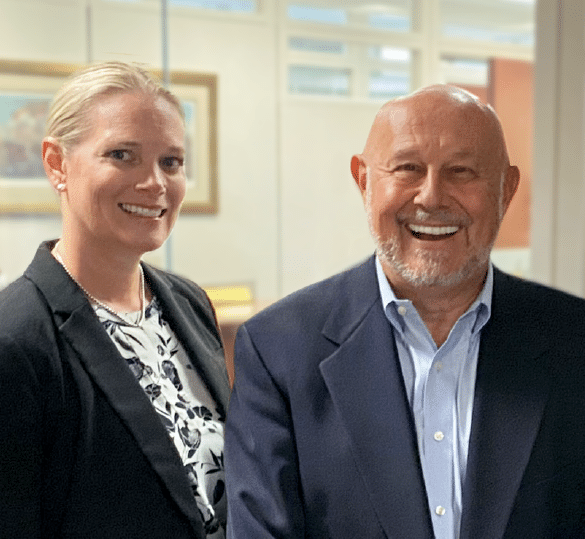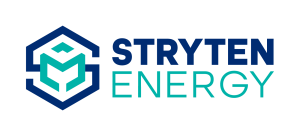We sat down with Stryten Energy’s Tim Vargo, CEO and Member of the Board, and Melissa Floyd, Vice President, Communications & Digital Marketing, to discuss the recent changes within the company’s Motive Power and Essential Power divisions.

In 2022 Stryten Energy announced that they would sunset the GNB Industrial Power name and unify go-to-market efforts under the Stryten Energy name. What was the driving factor behind that decision?
Tim:
In business, the best companies are promoting a single brand, not multiple brands. Some of our brands have stories that have been told that are no longer relevant today. Rather than trying to reframe those stories, we are focusing our energy on building that one great brand. Stryten Energy already has many positive attributes in the marketplace.
Melissa:
By unifying our go-to-market strategy under the Stryten Energy brand, we can share our message of company growth, quality, service, and being the most trusted partner to our customers to help solve their energy needs. The company is evolving, and these are exciting parts of the Stryten Energy story that our customers want to hear and be a part of.
Was the decision to rebrand made because you sold the GNB Industrial Power name?
Tim:
To paraphrase a quote from Mark Twain, rumors of our demise have been exaggerated.
We still own the GNB brand name, and we have no intention of selling it. The industry used to be dominated by a few strong battery companies, including GNB Industrial Power. But new companies and new technologies have come onto the scene, particularly in lithium. The established GNB name, while well-recognized in the lead battery market, didn’t necessarily signify a company on the leading edge of new battery and charging technologies.
The name GNB is not descriptive of what we do anymore. If you were in battery procurement in the sixties, you would know what the GNB name means, but not many of our customers are left from then. Stryten Energy provides a strong name that positions us for where the future of energy storage will take us.
Melissa:
This decision was based on data from quantitative and qualitative research from our customers and market research. We conducted several customer research studies in advance of this rebranding initiative. We measured our customers’ perception of the GNB name.
Armed with that information, it became obvious that consolidating our brands under the Stryten Energy name was the right direction for us and our customers. From there we started the journey of how to transition from the GNB name and refresh our industrial portfolio.
You recently unveiled new product names across the Motive Power and Essential Power divisions under the M-Series and E-Series banners. What was the reasoning behind the decision to move away from “vanity” product names to organizing Stryten’s batteries by application and technology?
Melissa:
When we looked at our portfolio, the variety of product names really didn’t fit into any kind of cohesive strategy.
Some names like Sprinter or Marathon alluded to a product attribute. LiFTFORCE sort of referenced the application – lift trucks. Our Tubular line centered around the battery technology. And others like GNB Classic didn’t speak to anything the product does. It was just a collection of accumulated product “brands” pulled together when the company was formed.
So, we asked ourselves, if we could start over, how would we build our product portfolio names? What would make sense to our customers and the market as a whole?
We wanted to put the focus on the master brand – Stryten Energy – and introduce a unified look and feel to our product labels. We also want to develop product names that would indicate the battery technology and a method to differentiate one battery type from another in a particular product family. What we came up with is simple, easy to follow, almost intuitive.
Tim:
Again, we looked at how other successful brands name their products. We found there is usually a method to the series, in the numerology or the alphanumeric naming of the products. We thought about our industrial customers, and the other parts and products they use in their business.
For example, think about the vehicles they use to move things around. They’re driving an F-150, an F-250, an F-350 or an F-450. They’re driving a 1500, a 2500, a 3500. That nomenclature in an industrial sense is easy to follow. The bigger the number, the more heavy-duty. There’s a continuity in that nomenclature that works.
How does this new naming style work with where you see the market going?
Tim:
There is a plethora of product names in the market right now. And very few of them have clear descriptors. There’s no clarity in what the battery is or what it does.
If you look at our customers, whether that’s a dealer customer, distributor customer, an OEM or an end user, they’re all dealing in part numbers every day with everything they deal with. And those part numbers don’t have a cute or fancy name in front of them. There’s an alpha and a numeric associated with each product, and that alpha means something, and the numeric means something.
Our naming convention is piggybacking on the industrial knowledge base that’s already there from a battery service technician standpoint or a user standpoint.
Melissa:
Another great benefit to re-imagining how we name our products is that as we bring new products to market for our customers, we have a structure already in place.
Product naming can be a part of the process that could really slow you down going to market. We aren’t going to have that roadblock any longer. As we develop new battery solutions or new charging solutions, we can immediately put that into our product portfolio in a way that makes sense for the market and for our customers. Accelerating our go-to-market strategy will be a quantifiable advantage as we grow our product portfolio.
How have partners and customers reacted to the new product names?
Tim:
Not only have we received very positive feedback so far, but we’ve also received a lot of encouragement to make this jump to unify under the Stryten Energy name. When we did the research and when we had conversations with our customers about this change, we got very positive support across the board to changing the dynamics of our branding and our part numbering.
We had the foresight to ask our customers what they thought, and so we already had a lot of buy-in at the front end. This rebranding is not only what we believe is the right direction, but it’s also what our customers and the industry says it wants.
Melissa:
While the GNB brand was widely recognized because it has been in the marketplace for decades, there wasn’t any particular allegiance to it. Our dealer partners didn’t see it as a necessary name to help them make a sale to their customers.
They really like the direction of the Stryten Energy name, the vision for this company, and they want to be a part of it. Some of our more qualitative research really brought that to light and they are excited about the future of the company, especially going beyond some of the traditional chemistries of lead batteries into new chemistries like vanadium flow and advanced lithium.
One of the biggest takeaways is that we’ve talked to our customers, we’ve brought them along on this journey as our partners, and we’ve provided the exact support that told us they need to help them through this transition and to be successful. We are living up to our vision to be the most trusted energy partner.
We recognize that change can be hard, but our customers have been overwhelmingly supportive and excited about the new day at Stryten with fresh new branding and marketing support materials. This excitement came through as we unveiled the new branding and shared our marketing strategy with our customers ahead of the public announcement.
What is on the horizon for Stryten’s Motive Power and Essential Power divisions?
Tim:
One of the things I think we’ve done a good job of over the past few years is listening to what our customers need and innovating products to solve those needs. Right now, our customers are asking for a domestic supply of lithium manufactured products. We’re going down that path of developing a North American assembled or manufactured lithium product. And although lithium’s a great solution for a variety of things, it has limitations on long duration storage. So, we’re moved into vanadium battery technology, with our vanadium redox flow battery system. By listening to what our customers have to say, we’re innovating solutions to solve the problems not only of today, but for decades to come.
Melissa:
Another innovation that we’re continuing to expand upon is our Stryten Energy inCOMMAND™ solution. That approach is really a differentiator in the market. It’s part of our commitment to our customers, working with them to understand their needs and coming to them in a more consultative and data-driven way to help solve their energy challenges and drive efficiencies in their businesses.
It’s not about what we can sell them out of what is on the shelves of our distribution centers. With inCOMMAND, we can look at the data from their fleet so we can find the right battery solutions for the right application for their unique needs. And our comprehensive battery portfolio gives us the flexibility to match the right technology to solve their challenges.
Melissa, how are you driving greater awareness for the unified Stryten Energy brand this year?
We like to say that the Stryten Energy is a new name, but not new to the game. For the past two plus years, we have been focused on building greater awareness of the Stryten Energy brand in the markets we serve. That included foundational work to establish our digital and social media platforms, as well as launching content marketing and public relations programs to communicate Stryten’s role in solving the world’s energy challenges.
There is never a lull in activity at Stryten, and we are continuing to build on the positive momentum of the company. Looking to the future, we are moving key elements of our brand strategy forward in exciting new ways. We recently debuted a refreshed website that better highlights our complete offering of advanced lead, lithium and vanadium batteries and provides insight into how Stryten Energy is supporting domestic energy security goals.
We are also increasing our communications cadence to amplify Stryten news and announcements across our paid, shared and owned communication channels. We are doubling down on positioning Stryten Energy at the forefront of our industry with our subject matter experts on important topics for the industries we serve. You’ll definitely be seeing and hearing more about Stryten whether it be online, at industry events or with strategic media outlets.
Tim, we’ll give you the last word. What excites you most when you think about Stryten’s future?
Tim:
I would have to say it’s the endless opportunities across the board. The need for energy storage solutions is expanding more rapidly than we could ever have imagined.
I’m amazed at how versatile our portfolio of products is becoming and how long they’re going to be applicable in the world of energy storage. Whether it’s our legacy products, which have an amazing future in today’s energy challenge solutions, compounded by the incredible work along the lithium and vanadium flow battery development. The application of these battery technologies in the global energy storage challenge is fascinating. They fit everywhere you look, whether they’re standalone, whether they’re working in concert with another product or with several products.







